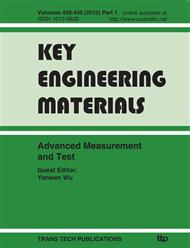[1]
FENG Xianzhang. Numerical Analysis of Distribution of Friction Force during H-Beam Rolling. Lubrication engineering, 2006, 178(6): 78-80.
Google Scholar
[2]
CUI Zhen-shan, LIU Cai, YU Bing-qiang, et al. Numerical Simulation of Rolling Pressure for H-Beam Hot Rolling. Journal of Iron and Steel Research, 2001, 13(3): 27-30.
Google Scholar
[3]
LI Yong, ZHENG Jian-rong, TANG Wei-feng. Analysis of Damping Material and Structure for Viscoelastic Suspensions Using Nonlinear FEM. Transactions of the Chinese Society of Agricultural Engineering, 2005. 1: 1-3.
Google Scholar
[4]
BU Yong-li. Finite Element Simulation of Three Stands Hot Continuous Rolling H-Beam, Qinhuangdao: Yanshan University , 1999: 38-43.
Google Scholar
[5]
Seong H K, Chul H P, Hyun C P, et al. Vibration control of an arc type shell using active constrained layer damping. Smart Materials and Structures, 2004, 13 (2): 350-354.
DOI: 10.1088/0964-1726/13/2/013
Google Scholar
[6]
Wang D W, Tzou H S, Lee H J. Control of nonlinear electro/elastic Beam and plate systems(Finite Element Formulation and Analysis) . J Vib Aco, 2004, 126 (1) : 63-70.
DOI: 10.1115/1.1640357
Google Scholar
[7]
LIU Chao-hong, HUANG Kuo. Study on mosaic-type solid lubricating materials for friction lining board in slab-strip steel coilers. Heavy Machinery, 2007, 3: 3-4.
Google Scholar
[8]
MAN Da-hu, DING Hou-fu, DU Xiao- dong, et al. Resear- ch on Influence of Impact Power on Impact-corrosion Resistance of Low-carbon Hi-alloyed Steel Using as Scaleboard Material. Hot Working Technology, 2007, 7: 7-9.
Google Scholar
[9]
Xue Ji-zhong, YI Chuan-yun. Three Dimension Finite Element Analysis of Bridge-Crane Frame Structure. Journal of Machinery & Electronics, 2004, 8: 12-15.
Google Scholar
[10]
Gu liang, Wang Guoli, Dong Mingming, et al. Simulation study on active roll control of vehicles. Journal of Beijing Institute of Technology, 2000, 9(4): 439-444.
Google Scholar
[11]
Grimble MJ. A non-circular arc roll force model for cold rolling. International Journal for Numerical Methods in Engineering, 1978, 12: 643-663.
DOI: 10.1002/nme.1620120409
Google Scholar
[12]
M. COSTELLO AND J. KYLE. A Method for Calculating Static Conditions of a Dragline Excavation System using Dynamic Simulation . 2004, (4): 233-247.
DOI: 10.1016/j.mcm.2004.03.001
Google Scholar
[13]
X. Xing, X. shu, Z. Hu. Real-time testing system of displacement of the end of workpieces in multi-wedge cross wedge rolling, J. Univ. Sci. Technol. Beijing, 2004 26(5): 548-550.
Google Scholar
[14]
Yuli LIU, Won-Ho LEE. Mathematical model for the thin strip cold rolling and temper rolling process with the influence function method. ISIJ International, 2005, 45(8): 1173-1178.
DOI: 10.2355/isijinternational.45.1173
Google Scholar
[15]
Y. Dong, T. Ka, L. Mr, Z. Deng. Analysis of stress in cross wedge rolling with application to failure, nt.J. Mech. Sci. 2000, (42): 1233-1253.
Google Scholar
[16]
XU Shaohong; LIU Xiao. Feasibility analysis of producing hot rolled TRIP steels using TSCR process. Forging & Stamping Technology, 2007, 4: 23-25.
Google Scholar


